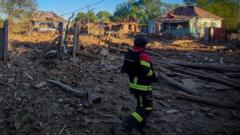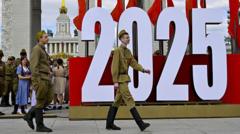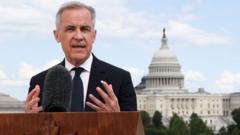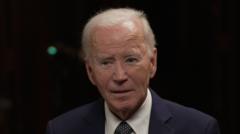In a recent outburst, former President Trump criticized Ukrainian President Zelensky after he rejected a U.S.-backed proposal aimed at ending the ongoing conflict with Russia. The plan includes significant concessions to Russia, which Zelensky firmly dismissed.
Trump's Ultimatum to Zelensky: Peace or Prolonged Conflict

Trump's Ultimatum to Zelensky: Peace or Prolonged Conflict
Tensions escalate as Trump pressures Ukraine to accept controversial peace terms with Russia
Former President Donald Trump publicly reprimanded Ukrainian President Volodymyr Zelensky for declining a U.S. peace proposal aimed at resolving the ongoing war with Russia. On social media, Trump claimed Zelensky faced a stark choice: “He can have Peace or, he can fight for another three years before losing the whole Country.”
The peace proposal, articulated by Vice President JD Vance, calls for a cessation of territorial disputes following three years of conflict, recognition of Russia's annexation of Crimea, and Ukraine's commitment to refrain from joining NATO. This marks one of the first instances where a U.S. official has clearly presented a plan that is perceived as favoring Russian interests. Vance emphasized that the U.S. would disengage from negotiations if both Ukraine and Russia failed to accept the proposed terms, implying significant pressure on Zelensky.
In response, President Zelensky firmly rejected any notion of legitimizing Russia’s 2014 occupation of Crimea, stating, “There is nothing to talk about... This violates our Constitution. This is our territory, the territory of the people of Ukraine.” He reiterated Ukraine's rights, clearly signaling that such terms are unacceptable.
Trump accused Zelensky of making “inflammatory” statements regarding the conflict and questioned his commitment to regaining Crimea, suggesting, “If he wants Crimea, why didn’t they fight for it eleven years ago when it was handed over to Russia without a shot being fired?” He warned that Zelensky's comments could escalate the situation, stating, “The statement made by Zelenskyy today will do nothing but prolong the ‘killing field,’ and nobody wants that.”
At present, Russian forces occupy nearly 20 percent of Ukrainian territory, and a freeze on territorial changes would necessitate Ukraine yielding large areas to Russia, a prospect that is deeply contentious within Ukraine’s political landscape.
The peace proposal, articulated by Vice President JD Vance, calls for a cessation of territorial disputes following three years of conflict, recognition of Russia's annexation of Crimea, and Ukraine's commitment to refrain from joining NATO. This marks one of the first instances where a U.S. official has clearly presented a plan that is perceived as favoring Russian interests. Vance emphasized that the U.S. would disengage from negotiations if both Ukraine and Russia failed to accept the proposed terms, implying significant pressure on Zelensky.
In response, President Zelensky firmly rejected any notion of legitimizing Russia’s 2014 occupation of Crimea, stating, “There is nothing to talk about... This violates our Constitution. This is our territory, the territory of the people of Ukraine.” He reiterated Ukraine's rights, clearly signaling that such terms are unacceptable.
Trump accused Zelensky of making “inflammatory” statements regarding the conflict and questioned his commitment to regaining Crimea, suggesting, “If he wants Crimea, why didn’t they fight for it eleven years ago when it was handed over to Russia without a shot being fired?” He warned that Zelensky's comments could escalate the situation, stating, “The statement made by Zelenskyy today will do nothing but prolong the ‘killing field,’ and nobody wants that.”
At present, Russian forces occupy nearly 20 percent of Ukrainian territory, and a freeze on territorial changes would necessitate Ukraine yielding large areas to Russia, a prospect that is deeply contentious within Ukraine’s political landscape.




















